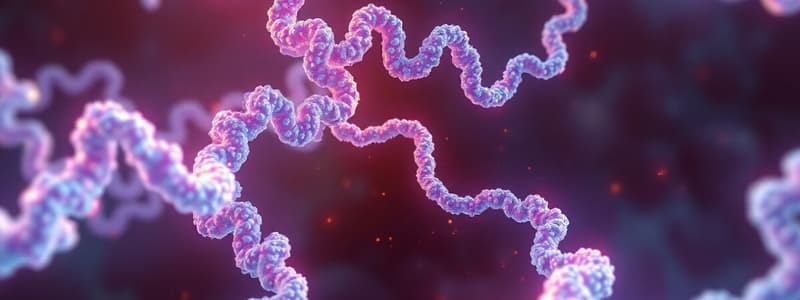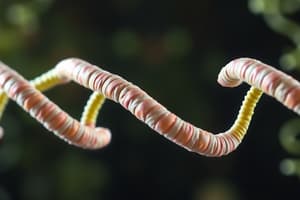Podcast
Questions and Answers
What does the term 'secondary structure' refer to in proteins?
What does the term 'secondary structure' refer to in proteins?
Secondary structure refers to localized regions of protein where amino acids fold into regular structures, such as alpha helix and beta sheets. These structures are stabilized by hydrogen bonds.
Glycine is often found in alpha helix structures.
Glycine is often found in alpha helix structures.
False (B)
What are the main types of secondary structure in a protein?
What are the main types of secondary structure in a protein?
- Alpha helix and Beta pleated sheet (correct)
- Alpha helix and Gamma helix
- Omega helix and Beta pleated sheet
- Beta pleated sheet and Gamma helix
What is the difference between a parallel and antiparallel beta-pleated sheet?
What is the difference between a parallel and antiparallel beta-pleated sheet?
What are beta turns and what is their role in protein structure?
What are beta turns and what is their role in protein structure?
What are loops in protein structure and what role do they play?
What are loops in protein structure and what role do they play?
What is tertiary structure in proteins and how is it maintained?
What is tertiary structure in proteins and how is it maintained?
What is the role of disulfide bonds in tertiary protein structure?
What is the role of disulfide bonds in tertiary protein structure?
Hydrophobic interactions are the primary force driving protein folding.
Hydrophobic interactions are the primary force driving protein folding.
Explain what is meant by the term 'quaternary structure' in proteins.
Explain what is meant by the term 'quaternary structure' in proteins.
What are the common types of subunits in proteins?
What are the common types of subunits in proteins?
What is the major difference between homooligomers and heterooligomers?
What is the major difference between homooligomers and heterooligomers?
What are the main stabilizing factors involved in quaternary protein structure?
What are the main stabilizing factors involved in quaternary protein structure?
What does protein denaturation refer to, and what factors can cause it?
What does protein denaturation refer to, and what factors can cause it?
When an egg is cooked, the heat primarily denatures the proteins in the yolk rather than the egg white.
When an egg is cooked, the heat primarily denatures the proteins in the yolk rather than the egg white.
Flashcards
Secondary structure
Secondary structure
It is a localized region within a protein where the polypeptide chain folds into regular, repeating structures, such as alpha helices and beta sheets.
Alpha helix
Alpha helix
A helical shape that is a type of secondary protein structure. It is stabilized by hydrogen bonds between the backbone of the polypeptide chain.
H-bond in alpha helix
H-bond in alpha helix
A hydrogen bond formed between the amino group of one amino acid and the carboxyl group of another amino acid in the alpha helix structure.
Alpha helix breakers
Alpha helix breakers
Signup and view all the flashcards
Beta sheet
Beta sheet
Signup and view all the flashcards
Antiparallel beta sheet
Antiparallel beta sheet
Signup and view all the flashcards
Parallel beta sheet
Parallel beta sheet
Signup and view all the flashcards
Beta turn
Beta turn
Signup and view all the flashcards
Loop
Loop
Signup and view all the flashcards
Tertiary structure
Tertiary structure
Signup and view all the flashcards
Disulfide bond
Disulfide bond
Signup and view all the flashcards
Non-covalent interactions
Non-covalent interactions
Signup and view all the flashcards
Hydrophobic interactions
Hydrophobic interactions
Signup and view all the flashcards
Oligomeric protein
Oligomeric protein
Signup and view all the flashcards
Quaternary structure
Quaternary structure
Signup and view all the flashcards
Monomer
Monomer
Signup and view all the flashcards
Homodimer
Homodimer
Signup and view all the flashcards
Heteroligomer
Heteroligomer
Signup and view all the flashcards
Protein hydrolysis
Protein hydrolysis
Signup and view all the flashcards
Denaturation
Denaturation
Signup and view all the flashcards
Protein solubility
Protein solubility
Signup and view all the flashcards
Heat denaturation
Heat denaturation
Signup and view all the flashcards
Mechanical denaturation
Mechanical denaturation
Signup and view all the flashcards
pH denaturation
pH denaturation
Signup and view all the flashcards
Organic compounds denaturation
Organic compounds denaturation
Signup and view all the flashcards
Detergent denaturation
Detergent denaturation
Signup and view all the flashcards
Urea and guanidine hydrochloride denaturation
Urea and guanidine hydrochloride denaturation
Signup and view all the flashcards
Reducing agents denaturation
Reducing agents denaturation
Signup and view all the flashcards
Native conformation
Native conformation
Signup and view all the flashcards
Study Notes
Biochemistry Study Notes
- Authors: Besan Al-ameir, Waqar Alfaqeer
- Editor: Dr. Nafez Abutarboush
- Year: 2024
- Sheet Number: 18
Protein Structure
- Protein synthesis involves building up the protein, following steps, and how the structure relates to its function.
- Defects in the protein structure can lead to diseases.
- Secondary Structure: Localized areas of proteins where they warp around each other, creating a more stable structure. This folding reduces energy and creates a stable arrangement due to polar and non-polar amino acids.
- Amino acid residues have bonds that rotate freely.
- The bond between the α-carbon and the amino nitrogen, and the bond between the α-carbon and the carboxyl carbon, affect stability.
- Hydrogen bonding leads to the arrangement of a polypeptide chain.
- The polypeptide chains fold into regular structures such as alpha helices, beta-pleated sheets, and loops.
Alpha Helix
- A specific secondary structure with a characteristic shape.
- 3.6 amino acids form one turn every 18 amino acids.
- The linear distance between corresponding points of turns (pitch) is 5.4 Å.
- The R groups of amino acids protrude outwards from the helix.
- Glycine and proline are not typically found in alpha helices due to their steric hindrance and lack of rotation.
- Other amino acids with branched groups, or close positioning of charged amino acids, may also affect the helix formation.
Beta-Pleated Sheets
- Composed of two or more strands with hydrogen bonds between them.
- Typically form a zig-zag pattern.
- The hydrogen bonding is greatest when the sheet bends and forms the pleated nature.
- Amino acids with branched R groups, or aromatic amino acids, tend to be more present in beta-pleated sheets.
- Proline and glycine may disrupt beta-sheet structures.
Beta-Turns
- Compact, U-shaped secondary structures. These connect beta-sheets.
- Also called hairpin bends, they are stabilized by specific interactions (e.g., hydrogen bonding).
- Common amino acids in these structures are glycine and proline.
Loops and Coils
- Irregular shapes that link sections of secondary structure.
- Very diverse in shape, and often found on the surface of proteins.
- Amino acids in loops may not be conserved.
- Loops contribute to the flexibility of proteins, important for interactions.
Protein Interactions (Additional Information)
- Loops in ligands and antigens contribute to their interactions.
- Loops provide flexibility and adaptability for precise interactions.
- Loops contribute to binding specificity and strength.
- Loops enhance binding affinity and specificity for interactions.
- Loops' structural diversity enables protein complexes with various recognition and specificity.
Tertiary Structure
- 3D arrangement of the polypeptide chains.
- Includes the arrangement of amino acids that are far apart in the primary sequence.
- Stabilized by various forces; covalent, hydrogen, hydrophobic, van der Waals, and electrostatic interactions, and environmental factors.
- Myoglobin has a tertiary structure.
Quaternary Structure
- Proteins composed of two or more polypeptides.
- Subunits can be identical (homo) or different (hetero). The arrangement.
- Subunits may be connected via disulfide bonds or non-covalent bonds.
Properties of Proteins: Denaturation
- Proteins can be denatured by extreme pH, heat or organic compounds.
- Factors like heat, pH extremes and organic compounds disrupt weaker forces like hydrogen bonding.
- This unfolding of the protein disrupts its function.
Studying That Suits You
Use AI to generate personalized quizzes and flashcards to suit your learning preferences.




